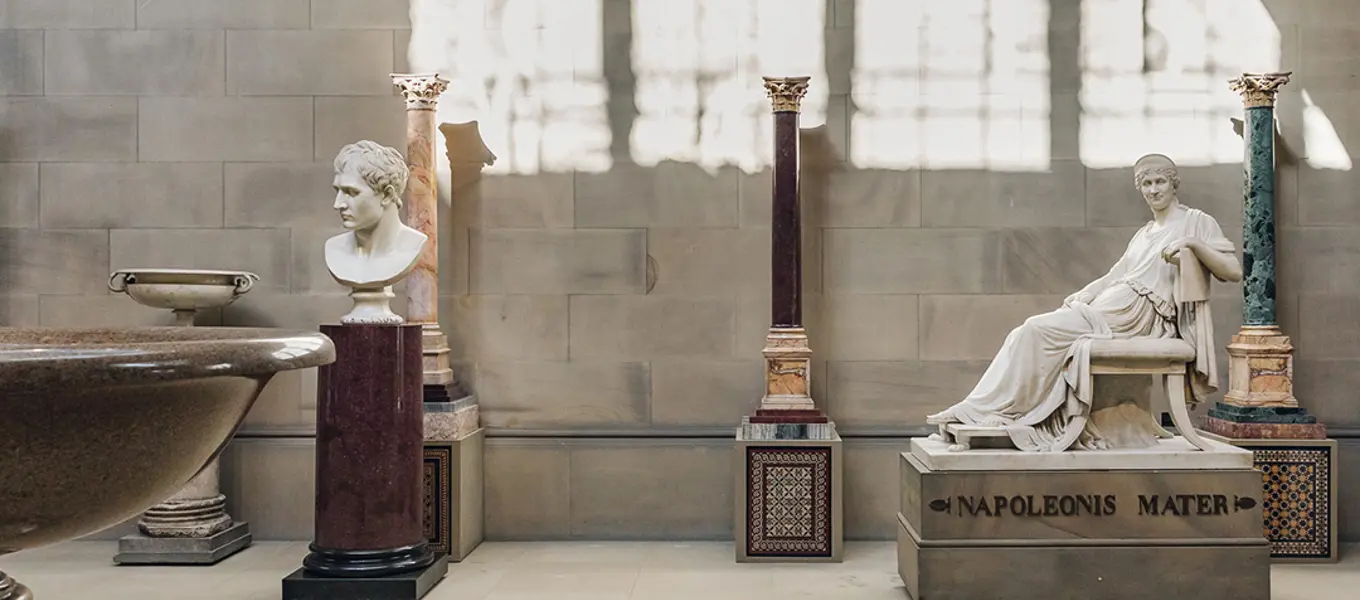At the time that the 6th Duke was creating this gallery, between 1818 and 1834, the fashion for collecting ancient sculpture which had dominated in the previous century meant that very few specimens were available for him to buy. Instead the 6th Duke’s passion for marble sculpture led him to form a collection of early 19th century European sculpture and it remains one of the most important in the world still in its original location.
Today the gallery is displayed as it was at the end of the 6th Duke’s life.
“My gallery was intended for modern sculpture, and I have almost entirely abstained from mixing it with any fragments of antiquity: It was in vain to hope for time or opportunities of collecting really fine ancient marbles.”
- 6th Duke of Devonshire
The collection features works by some of the best sculptors of the time including: John Gibson (1786-1866), Rudolph Schadow (1786-1822), Lorenzo Bartolini (1777-1850), Michael von Schwanthaler (1802-1848) and Bertel Thorvaldsen (1770-1844).

There are also six works by the most celebrated sculptor of the day, Antonio Canova (1757-1822), including the colossal bust of Napoleon in the centre of the gallery and the seated figure of Napoleon’s mother Madame Mere. One of Canova’s masterpieces, the figure of the sleeping shepherd boy Endymion with his dog, was a commission from the 6th Duke.
In 1819 he asked Canova to make him a figure, but gave him no further instruction. The 6th Duke wanted the creative genius of the artist to be completely unrestrained, and Endymion is the result. The highly polished marble surface of the shepherd boy’s skin represents the lustre of moonlight as he sleeps.

One of the important inspirations for the gallery was the new top-lit Braccio Nuovo gallery in the Vatican in Rome. The 6th Duke wrote that he “admire[s] it extremely, and shall imitate much in a small scale at Chatsworth”. His initial plan was to clad the walls of the Sculpture Gallery with richly coloured marbles, combined with a floor of Swedish porphyry, to create a similar effect to the Braccio Nuovo. The watercolour artist William Hunt (1790-1864) recorded a trial conducted with some of the sculptures, columns and vases in the Old Library in 1827.
The scheme was however abandoned in favour of the local gritstone used to build Chatsworth. This was for two reasons: firstly, the great expense of the coloured marbles, and secondly, the effect of reflected light. A number of the artists working for the 6th Duke advised him that the Derbyshire matt gritstone would create a better backdrop for the white statuary marble of the sculptures. Colour is still prevalent in the gallery through the use of specimen marble plinths and other objects, and marble table tops and panels inlaid with pietra dura.
This use of colour, together with the original arrangement of the sculptures according to the 6th Duke’s plans, was recreated in 2009 following a two-year research project. The rearrangement was first prompted by the filming of Pride and Prejudice in 2004. The 2009 representation revealed subtle narratives that existed in the placement of the sculptures.
One of the most striking effects was the restoration of the lions at the end of the gallery to their original height so that they once more tower over visitors as they exit the Gallery. The lions are copies after Canova’s originals on the tomb of Pope Clement XIII (1693-1769) in St Peter’s in the Vatican. The Chatsworth lions form a memorial of their own, placed either side of a great marble doorcase overlooked by busts of Antonio Canova and the 6th Duke, artist and patron respectively, and creators of this Gallery.
The 6th Duke so admired Canova that he even acquired the artist’s tools for sculpting clay models, placing them on display in a marble tazza. Later they were moved to the wall of the Gallery in a small glass case like some venerated treasure.

Explore more...
Painted Hall
Used to welcome and impress guests, this was the largest and grandest room built by the 1st Duke.
Oak Room
This room was completely changed by the 6th Duke with the wood panelling he bought at an auction.
Chapel
This is the least changed room at Chatsworth, the 1st Duke employed the best artists to realise his designs.
State Drawing Room
The second room of the State Apartment, a suite of rooms intended to host a king.
State Bedchamber
One of the most private rooms in the State Apartment, this room was more lavishly decorated than all the others and features the State Bed.
Old Master Drawings Cabinet
This room was designed to display Old Master Drawings.
North Sketch Gallery
The North Sketch Gallery, created in 2009, showcases contemporary art and ceramics.
Oak Stairs/Leicester Landing
The stairs were created when the 6th Duke added the North Wing. They connected the old part of the house to the new.
Library and Ante Library
There are over 17,000 books in these two rooms. The whole Chatsworth book collection numbers around 40,000 volumes.
Great Dining Room
Built as part of the 6th Duke’s renovation, this room is still used for formal dinners.
History of Chatsworth
Learn about the Devonshires and discover how they shaped the history of the house, garden and collection that we see today.
History of the garden
The garden evolved over nearly 500 years. Discover its history and the people who shaped it.
The Devonshire Collections
Discover highlights from the art, library and archive that make up the Devonshire Collections.
The House
Learn more about what's on in the house.



